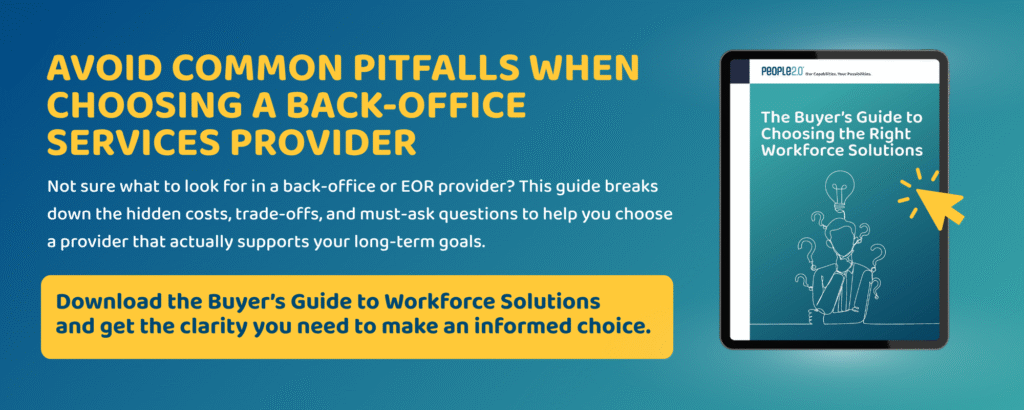Why doing everything in-house might be holding you back
Administrative work keeps businesses running, but it often drains time and energy that could be better spent elsewhere. HR staff, for instance, spend an enormous amount of time on admin — up to 57% of their day, according to Deloitte research.
For staffing firms, hours spent on tedious, repetitive tasks such as payroll, invoicing, onboarding, and compliance can mean delayed candidate placements and weakened customer relationships. Larger enterprises often face bigger, more complex admin headaches, with internal teams bogged down by audits and classification reviews.
While managing admin in-house is common, it does come with hidden costs that can be avoided with the right back-office partner. When outsourced, these services free up internal teams to focus on what drives value: placements, relationships, and strategic planning.
What Are Back-Office Services?
Back-office partners are HR specialists who manage essential workforce functions. These tasks are time-consuming and carry significant risk if mishandled. By managing them efficiently and accurately across the entire worker lifecycle, back-office partners enable internal teams to focus on hiring the right people and growing the business.
Back-office support can include:
- Payroll processing across geographies and worker types
- Tax filings and regulatory reporting, both local and global
- Timesheet and expense tracking
- Worker classification and compliance management
- Benefits administration
- Risk mitigation through audit-ready documentation and legal oversight
Back-Office vs. Front-Office Roles
While front-office teams drive revenue and relationships, back-office teams handle the operations that support them. Together, they form a complete workforce ecosystem. Here’s how they compare:
| Front-Office | Back-Office Services |
|---|---|
| Talent acquisition | Payroll processing |
| Client relationship management | Tax and regulatory compliance |
| Business development | Invoicing and collections |
| Workforce strategy | Worker classification and risk review |
| Service delivery | Timesheet and benefits administration |
The Hidden Costs of Managing Back-Office Functions In-House
At first glance, handling back-office functions in-house may seem like the more straightforward or budget-friendly choice. But it can introduce risk and lead to financial strain in the long run.
Significant Operational Investment
Building and maintaining back-office infrastructure is expensive. Staffing firms may need to hire dedicated specialists or rely on stretched internal teams. Enterprises, especially those operating across borders, often require costly systems to manage payroll and compliance. These expenses quickly add up and tend to scale as the managed workforce grows.
Productivity Loss Across Teams
Every hour spent on admin is time diverted from high-value work. In fact, studies have shown that employees spend up to 40% of their time just searching for the information they need.
When you combine that inefficiency with an already heavy workload, in-house admin slows decision-making and pulls internal staff away from strategic priorities.
Compliance Risk Grows with Complexity
According to Staffing Industry Analysts, compliance issues, particularly wage-and-hour laws and data privacy, rank among the top concerns for staffing leaders. And for good reason. Even small missteps can lead to costly penalties and even reputational damage.
Compounding the issue, regulations around payroll, taxes, and worker classification vary by region and shift frequently, making it hard for internal teams to keep up.
Why Outsourcing Back-Office Services Makes Strategic Sense
Offloading administrative tasks relieves admin strain while delivering measurable business value:
- Cost Control: Outsourcing replaces variable internal costs like staffing and software with a fixed, transparent model. The result is easier budgeting and greater control over administrative costs as the business grows.
- Trusted Expertise: With regulations constantly changing, it’s easy for internal teams to fall behind. Outsourced partners provide audit-ready processes and localized legal knowledge that reduce exposure and improve peace of mind.
- Scalable Growth: Outsourcing enables businesses to expand into new markets and manage seasonal surges without growing internal overhead.
- Talent Acquisition Advantage: By outsourcing administrative work, HR teams can redirect their energy towards placements, ensuring candidates are brought on board faster without bottlenecks.
- Data and Insights: Modern providers offer real-time reporting and analytics, giving you visibility into performance and compliance at every level.
A strong partner standardizes processes, laying the groundwork for scalable operations and new market entry. With the right processes in place, businesses can expand without reinventing the wheel in every region or business unit.
How Back-Office Services Support Staffing Firm Growth
When new client demand hits, staffing firms often face the same paradox: they need to move faster but are bogged down by the very infrastructure meant to support them. The pressure to scale creates resource strain. At the same time, administrative work piles up at the expense of strategic activity. Without intervention, these challenges can cap a firm’s potential just when it should be accelerating.
Back-office services help firms move past these constraints by streamlining onboarding and managing paperwork. Payment cycles improve when timesheets, invoicing, and collections are handled through an integrated system that keeps things moving without manual follow-up.
Compliance is another area where support makes a difference. As firms grow, the risk of misclassification or missed tax filings increases. Back-office providers take ownership of these requirements, ensuring firms stay aligned with local laws even as hiring becomes more complex.
This support allows staffing firms to expand into new regions without building local infrastructure or navigating regulations alone, key factors when competing against larger agencies. With smoother processes in place, candidates move through onboarding with fewer delays, and clients experience more consistent delivery. The paradox shifts. Now, firms can drive growth without adding complexity or overextending their teams.
How Back-Office Services Help Enterprises Scale Workforce Management
Large enterprises face the operational challenge of managing a workforce that spans employment types, business units, and borders. As the business grows, the work of keeping everything aligned becomes more complicated and harder to control.
Back-office services simplify complex operations by applying a standardized model across teams, functions, and geographies. Standardizing these functions removes unnecessary obstacles and allows work to move forward without repeated adjustments.
This consistency also creates the foundation needed to support broader strategic initiatives. Programs like direct sourcing and total talent management rely on accurate, real-time data and centralized workflows. A strong back-office partner provides the infrastructure to execute these strategies at scale, without overloading internal teams.
Compliance becomes more manageable as well. A qualified provider monitors regional laws and applies them across the workforce, lowering the risk of errors and ensuring alignment with local regulations.
Once the foundation is in place, talent teams can execute direct sourcing more quickly. There’s no need to wait for new systems or repeat legal reviews. With one provider managing key functions, reporting becomes clearer and spending is easier to track.
By replacing patchwork systems with a unified approach, back-office services enable enterprises to scale with greater control and strategic alignment.
How Back-Office Services Integrate with EOR/AOR Solutions
Employer of Record (EOR) and Agent of Record (AOR) providers offer a specialized service by taking on the legal responsibilities of employment, including contracts, tax filings, benefits administration, and compliance with local labor laws. This complements back-office services, which cover operations like payroll processing, timesheet tracking, invoicing, and reporting.
Working with a provider offering EOR, AOR, and back-office services as a unified solution removes friction from managing your workforce because everything runs through one system and one team. You don’t have to coordinate between vendors or resolve conflicts between different processes. This alignment ensures a smoother day-to-day while reducing the chance of errors entering your system.
Working with one provider also gives teams a clearer view of the workforce. You can track onboarding progress, monitor payroll status, and flag compliance risks through a single platform.
What to Look for in a Back-Office Service Provider
Choosing the right back-office partner is a strategic decision. The wrong fit can slow operations and increase risk; the right one becomes a true extension of your team, enabling growth and driving long-term value. Here’s what to prioritize when looking for administrative outsourcing:
Deep Industry Expertise
Look for providers who understand the nuances of staffing models or enterprise workforce strategies across regions, worker types, and regulatory environments.
Robust Technology and Integration Capabilities
Modern back-office support should run on secure, scalable platforms. Expect automation, accuracy, and real-time visibility as standard.
Global Reach and Local Knowledge
Ensure your provider has a global footprint and in-region experts who understand local tax, employment, and compliance obligations.
Transparent Service Level Agreements (SLAs)
Look for transparent service-level agreements that define turnaround times, error handling, and compliance standards.
Cultural Fit and Business Alignment
Choose a partner whose communication style, flexibility, and long-term goals align with your own, whether you’re scaling fast or optimizing enterprise-wide operations.
Analytics and Reporting Capabilities
Your provider should offer more than dashboards. Look for meaningful insights into onboarding, payroll timelines, compliance, and workforce trends to inform smarter decisions.
People2.0’s Approach to Back-Office Solutions
At People2.0, we deliver one of the most comprehensive workforce support platforms available, combining Employer of Record and Agent of Record (AOR) with full-service back-office support. Our single, integrated solution covers the entire workforce lifecycle, from onboarding and payroll to invoicing, tax compliance, and more.
Our offerings include:
- A global compliance infrastructure spanning over 60 countries
- In-region legal and tax experts who understand local regulatory nuances
- Scalable systems that adapt to growing and evolving workforce needs
- Transparent pricing structures and performance reporting for full accountability
Our solution is designed to meet the specific needs of your organization — whether you’re a staffing firm focused on rapid placements or an enterprise coordinating full-time, freelance, and contingent talent.
Simplify Your Back Office
Managing a workforce, whether local or global, permanent or contingent, is complex enough. Your back office shouldn’t make it harder.
Back-office partners handle the operational heavy lifting so your team can focus on what matters most: growing the business and supporting your people.
Ready to simplify your back office and scale your operations? Schedule a consultation to discuss how People2.0 can add value to your business. We can also show you how our workforce solution can help you overcome your unique challenges.




